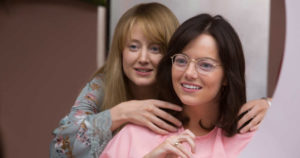
For good and ill, the national cinema of any country is generally defined (and sometimes reflexively driven) by associated tropes, stereotypes, and key images. The French film is existential, black and white (or at least “arty”), and pretentious. The American film is bombastic, loud, and popcorn-ready. Indian film is three-hour Bollywood pictures with an endless parade of song and dance numbers. And Japanese horror is little girls with long black hair, curses brought on by technology, and deep, melancholy sadness. Of course, not all Japanese horror is like this, but it’s safe to say that the early 2000s J-horror boom in America (and, as such, the western perception of the national style) was predicated on this perceived character. What set Ringu and Ju-on apart (and what made most American remakes of Japanese horror films save The Ring utter failures) is a throughline of sadness–this sense of not so much animal terror as a feeling of fatalistic hopelessness.
Jockeying for a place in this tradition is Aragne: Sign of Vermillion, a new one-man production by Saku Sakamoto, most famous for his digital effects in Ghost In the Shell 2: Innocence. Directing, writing, animating, and composing the music for the film by himself, Sakamoto has bitten off a massive project for himself, and, I’m happy to report, generally succeeds at all of these roles. Aragne follows a student named Rin Shiida who recently moved to a falsely advertised new apartment building on a reclaimed industrial site. On the news every day are reports of women being murdered, all of their heads turned at a ninety degree angle (and most of them shown to the viewer in Junji Ito-style grotesqueness), and Rin begins seeing bugs of various kinds bursting out of animals everywhere, starting with beetles but soon involving her dead old neighbor, whose arm explodes with giant grub worms with no one else seeming to notice. Soon she begins investigating, alerting suspect and mysterious parties to her knowledge and existence.
Though there is more plot than this, the movie is at its best when these things fall away and Sakamoto focuses on his true talent: mood setting and tone pieces. This is where it most resembles its stylistic forebears, and especially comes closest to the masterful video game Silent Hill 4: The Room in its depiction of urban decay, social anxiety, and guilt. The score, rarely falling into horror stereotype string screeches or deep electric hums, instead highlights sorrowful piano phrases, just dissonant enough to sound unsettling but never losing their minor key tonality. There’s odd plucks and cheap drum machine kicks holding up rickety chord changes and melodies that verge toward atonal but never quite get there; imagine the Postal Service arranging songs by mid-period Scott Walker and you’re getting close.
The strongest asset (and what will be the biggest hurdle for viewers), however, is the animation, which is incredibly idiosyncratic in ways that toe the line between purposeful and budget-constrained, often times within the same scene. The strongest choice is in the design of the characters (especially Rin) who are given low-detail, flat color bodies and clothing, but hyper-detailed, at times almost photo-real eyes. It’s disconcerting, off-putting, and at first seems like a poor choice. By the end of the film, it feels essential, adding a humanity that the audience can never feel totally comfortable with, like there is someone real peeking out from inside an abstracted body. Given the Makoto Shinkai-adjacent skylines and backgrounds, the eyes imply a connection to the world around them that the minimalist character models (and their minimal animations) stand out strongly against. Where this sometimes falters, however, is in Sakamoto’s 3D animations, which veer between uncanny and cheap. There is a car model, in particular, that would not pass muster in a first-year CGI class. When it works, however, it echoes Where the Dead Go to Die, another one-man show that, despite its dreadful content, was also able to use its low budget as an asset in evoking the otherworldly. When things move in 3D in Aragne, they look like they are lifting out of the image–a supernatural use of the limitations of such animation seen as early as the original Ghost in the Shell.
As a whole package, Aragne: Sign of Vermillion succeeds in its evocation of discomfort, violence, and regret, despite the occasional wonky shot, clumsy myth-building, and unsatisfying ending. It’s a grimy good time through disquieting nightmare-scapes that will leave you haunted with more than jump scares or physical fear. Beneath the bodies bursting with bugs, the people crushed, cut, and broken, there’s an overriding sense of displacement, alienation, and inevitability that permeates the film. It’s scary to die, Aragne says, but it’s harrowing that you might not receive salvation when you do.
—
Aragne: Sign of Vermillion is premiering at the 2018 Fantasia International Film Festival.
Directed by Saku Sakamoto; written by Saku Sakamoto; starring Kana Hanazawa; 75 minutes.



 Derek
Derek
 Isabelle
Isabelle